Key Takeaways
- Playing activities like drawing and board games can significantly enhance a child’s fine motor skills and hand-eye coordination.
- Pediatric motor skills contribute to cognitive and social development. Thus, early diagnosis and intervention can lead to academic success.
- Encouraging independent tasks like dressing and feeding themselves can foster self-reliance and improve a child’s motor skills.
- Occupational therapy is essential in addressing motor skill issues and personalizing activities to promote skill development and independence.
- Printable activities such as coloring pages and line-tracing exercises can strengthen wrist muscles, enhance observational skills, and boost fine motor skills.
Understanding Fine Motor Skills
Fine motor abilities, the intricate symphony of tiny muscles in our fingers, hands, and forearms, play a pivotal role in a child’s growth. These complex muscle movements are essential in completing tasks such as writing, buttoning shirts, and using utensils, all of which contribute to the child’s expanding autonomy and self-assurance. For children with developmental concerns like autism, early diagnosis and intervention can play a vital role in improving these skills.
Mastery of fine motor abilities does not end with physical skill; it is also intertwined with cognitive growth. As children gain proficiency in these abilities, they experience improvements in academic performance, particularly in areas that require hand coordination. A child with well-developed fine motor skills may have an easier time learning to write, which can significantly increase their academic achievement.
In addition, developing fine motor skills can have lasting benefits for overall growth. As these small muscles are trained and honed, children gain a sense of mastery over their environment, leading to increased self-confidence and self-efficacy. Therefore, nurturing fine motor skills in childhood can set the stage for long-term success and independence, making it a key focus area for pediatric professionals.
Importance of Pediatric Motor Skills
Pediatric motor skills are integral to a child’s holistic development and are the foundation for physical, cognitive, and social growth. These skills encompass considerable and precise motor abilities and significantly influence a child’s movement and coordination. Particularly for autistic children, these skills can be a powerful tool to communicate and understand themselves better. They act as a catalyst, accelerating children’s overall development and academic success, and therefore cannot be overlooked.
- Precise Motor Skills: These skills involve exact movements of small muscle groups, vital for hand-eye coordination activities. These skills can be nurtured and improved through purposeful play activities, promoting healthy development.
- Motor Skills in Children: The early years of a child’s life are vital for enhancing motor skills. These skills are about physical growth and contribute to cognitive and social development, making them necessary for a child’s well-being.
- Role of Activities: Engaging children in challenging activities and improving their motor skills is essential. These activities provide opportunities for children to investigate their environment, learn new skills, and thus enhance their confidence.
Identifying Motor Skill Issues
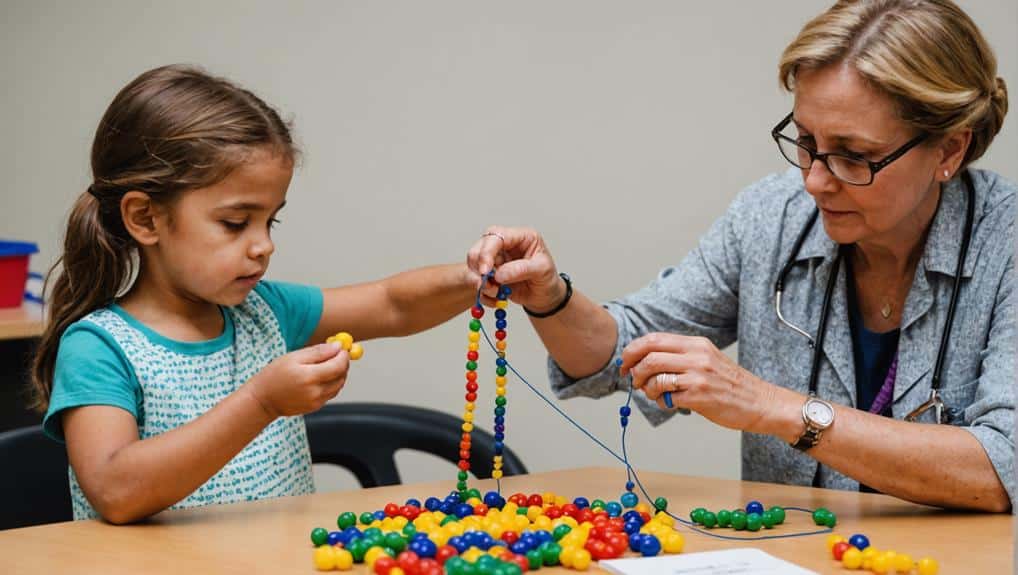
While motor skills play a pivotal role in a child’s cognitive and social development, recognizing the signs of potential motor skill issues is just as significant. Identifying these issues in the early stages of a child’s fine motor skills development can prevent complications such as poor handwriting, anxiety, and challenges with computer skills. This is especially true for children with autism, who may face exceptional challenges in their motor skills development.
Signs of motor skill problems can manifest as awkward pencil grasp, messy writing, or difficulty using scissors. Such issues may lead to behavioral changes, academic struggles, and low self-esteem. Hence, understanding these signals is essential for parents, caregivers, and educators. Advocates can also play a role in raising awareness about these early signs in the context of autism.
Identifying motor skill issues involves keen observation of the child’s hand dominance, finger strength, and bilateral integration. Hand dominance, for instance, is a critical aspect of fine motor skills development. A lack of clear hand dominance or a late switch of hand dominance can signal motor skill issues.
Moreover, a child’s finger strength and bilateral integration are crucial indicators of their motor skill development. Children with weak finger strength or poor bilateral coordination could be experiencing challenges.
In such cases, consulting an occupational therapist is recommended to evaluate further and address the child’s motor skill issues.
Role of Pediatric Occupational Therapy
Pediatric occupational therapy is essential in addressing children’s ice motor skill development issues. Its role is multifaceted, with a focus on fine motor skills play, developing fine motor skills, and designing tailored activities suited to each child’s individual needs.
- Occupational therapists assess and address neurological or physical differences affecting a child’s fine motor skills. They are skilled at identifying, understanding, and overcoming these challenges, assisting children in reaching their developmental milestones.
- Therapists design personalized activities, ensuring they are engaging and enjoyable for children. These activities promote skill development and nurture a sense of achievement and independence. This approach teaches children to navigate daily activities with increased confidence and skill.
- A significant aspect of occupational therapy is promoting school readiness. Therapists work diligently to improve a child’s fine motor skills, thus preparing them for tasks such as writing, cutting, and buttoning, which are vital for their academic progression.
In essence, occupational therapy plays a central role in fine motor skill development, promoting independence and preparing children for school, ultimately contributing to their overall well-being.
Activities for Boosting Motor Skills
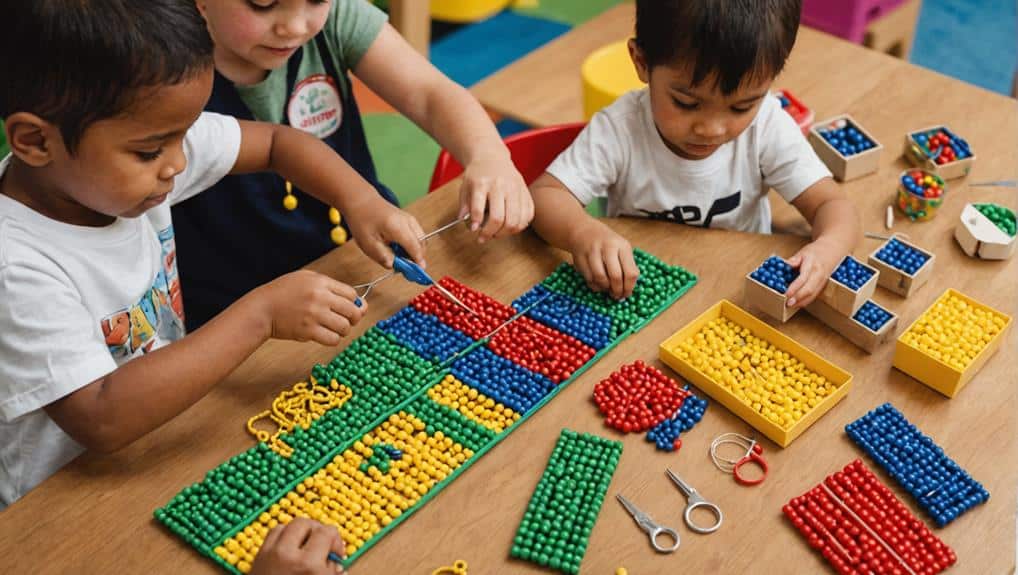
Often, children are naturally drawn towards engaging and fun-filled activities that stimulate their senses and encourage exploration. Sensory play activities, such as playing with sand or water beads, ignite a child’s curiosity and engage the small muscles in their hands and fingers. This motor skills play is essential for the development of fine motor skills.
Interestingly, these activities can also serve as a practical therapeutic approach for children on the autism spectrum. While some autistic individuals struggle with eye contact, engaging them in fine motor activities can provide a comfortable environment to express themselves and communicate effectively.
Art projects like drawing, painting, and molding clay are more than expressive outlets. They help build hand and finger strength, which is crucial for tasks requiring precision and control. Board games like LEGO Construction and Connect 4 are not merely sources of amusement but promote fine motor skills and hand-eye coordination.
Fine motor activities do not always have to be structured. Everyday activities such as playing magnet fishing games or aligning stickers also serve an essential role in enhancing hand-eye coordination. Finger painting and bead stringing, for instance, improve fine motor control. These enjoyable activities have the added benefit of strengthening motor skills, proving that learning can be satisfying.
Encouraging Independent Activities
Promoting self-reliance in children is more than just a step towards their growing independence; it is a critical component in developing fine motor skills. Engaging in independent activities, such as buttoning their shirts or pouring drinks, strengthens fine motor muscles and hand-eye coordination and instills a sense of accomplishment and self-confidence. As a result, it is imperative to discuss the significance of these activities and strategies to incorporate them effectively into a child’s daily routine for their comprehensive growth and development.
Fostering Self-Reliance
Fostering autonomous activities plays a pivotal role in the path toward childhood self-sufficiency. Encouraging tasks like dressing, brushing teeth, and feeding themselves promotes self-sufficiency in children. These independent tasks not only cultivate a sense of confidence but also help children develop crucial problem-solving skills.
As we explore further into fostering self-sufficiency, it’s crucial to remember:
- Start Early: Encouraging autonomous activities from a young age sets a strong foundation for lifelong self-sufficiency. This nurtures an environment where children feel capable and confident.
- Focus on Daily Tasks: Independence in daily activities leads to improved self-regulation skills. Mastering these tasks provides a sense of accomplishment that fuels their desire to take on new challenges.
- Patience is Key: The path to self-sufficiency is a gradual process. It’s vital to be patient and encouraging and to celebrate small victories along the way.
In essence, fostering independence in children is not just about encouraging them to perform tasks independently. It’s about nurturing a sense of confidence, problem-solving skills, and a deep-rooted sense of accomplishment that will serve them well in all future endeavors.
Play-Based Skill Development
Understanding the importance of play in developing children’s fine motor skills is fundamental. Play-based skill development encourages children to engage in independent activities, fostering creativity and problem-solving skills.
These activities, whether manipulating puzzles, building blocks, or drawing, allow children to explore and practice fine motor skills at their own pace. This hands-on approach nurtures their confidence and stimulates their creative thinking, a crucial aspect of cognitive development.
Using tools during play-based activities significantly improves hand-eye coordination, an essential element of fine motor skills. Manipulating tools, such as pencils or toy tools, strengthen the small muscles in the hands, which are necessary for performing delicate motor tasks.
Therefore, our crucial role as caregivers and educators is to encourage play-based skill development. By doing so, we promote independent activities and equip children with a necessary toolkit for their future success. This approach allows them to develop, practice, and refine fine motor skills while fostering autonomy, creativity, and problem-solving capabilities.
Printable Activities for Skill Building
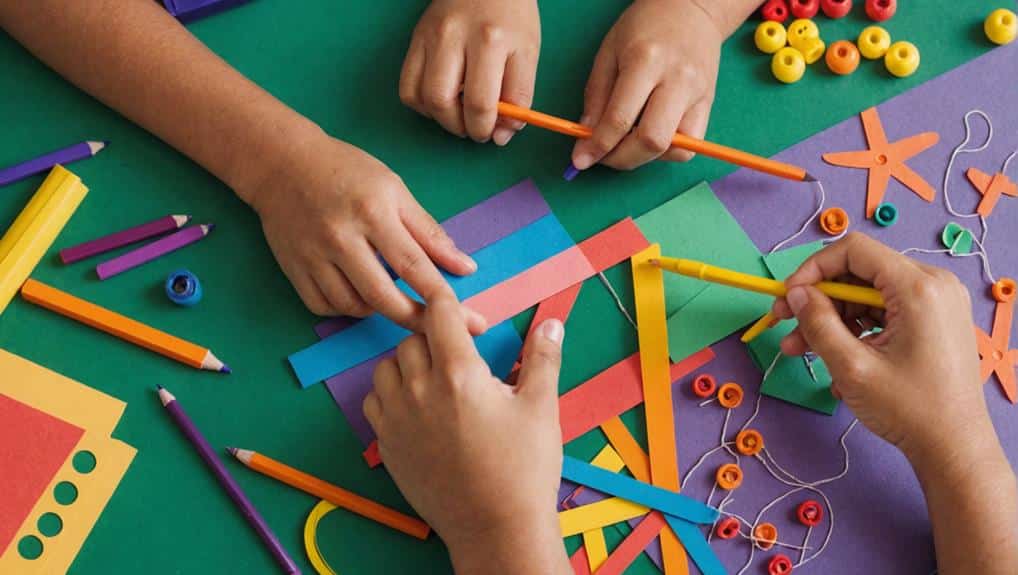
Numerous printable activities, such as coloring pages and grid drawings, are vital tools for strengthening wrist muscles and improving hand-eye coordination in children. Engaging in delicate motor tasks in these activities stimulates the small muscles in the hand, fostering skill and precision. In addition to these benefits, mindfulness activities like meditation can also help children with autism better focus on the task at hand and manage any sensory overloads.
Printable activities offer a myriad of benefits:
- They enrich observational skills, as children must pay close attention to detail to follow line-tracing exercises accurately.
- They refine their drawing abilities. With consistent practice, children can hone their control over their wrist muscles, gradually improving their drawing skills.
- They encourage creativity. Given the open-ended nature of these activities, children have the freedom to express their creativity, further enhancing their motivation to engage in these tasks.
In essence, printable activities serve as an advantageous platform for developing fine motor skills. They foster hand-eye coordination and instill a sense of accomplishment in children, promoting their will to learn and grow. As we continue to support the development of our children, let’s optimize these tools to encourage their success.
Fine Motor Skills After Childhood
The need for strong fine motor skills does not diminish as we age. Quite the opposite, adults often need to regain and refine these skills, especially following neurological injuries. Occupational therapy is vital in diagnosing fine motor skill deficits and creating tailored treatment plans.
A cornerstone of occupational therapy for adults is engaging in fine motor activities. These can range from basic self-care tasks like dressing and brushing teeth to more complex activities like drawing, folding clothes, and using scissors. Such tasks help regain lost skills and improve independence, a critical aspect of adult life.
Below is a table detailing some standard techniques used in occupational therapy for adults:
| Activity | Purpose | Outcome |
|---|---|---|
| Dressing | Enhance dexterity | Improved independence |
| Drawing | Enhance precision | Improved hand-eye coordination |
| Folding Clothes | Enhance coordination | Increased self-sufficiency |
| Using Scissors | Enhance grip strength | Improved fine motor skills |
These techniques underscore the significance of fine motor skills for adults. They provide a clear pathway for regaining independence, demonstrating occupational therapy’s profound impact in improving lives.
Therapy for Fine Motor Skills
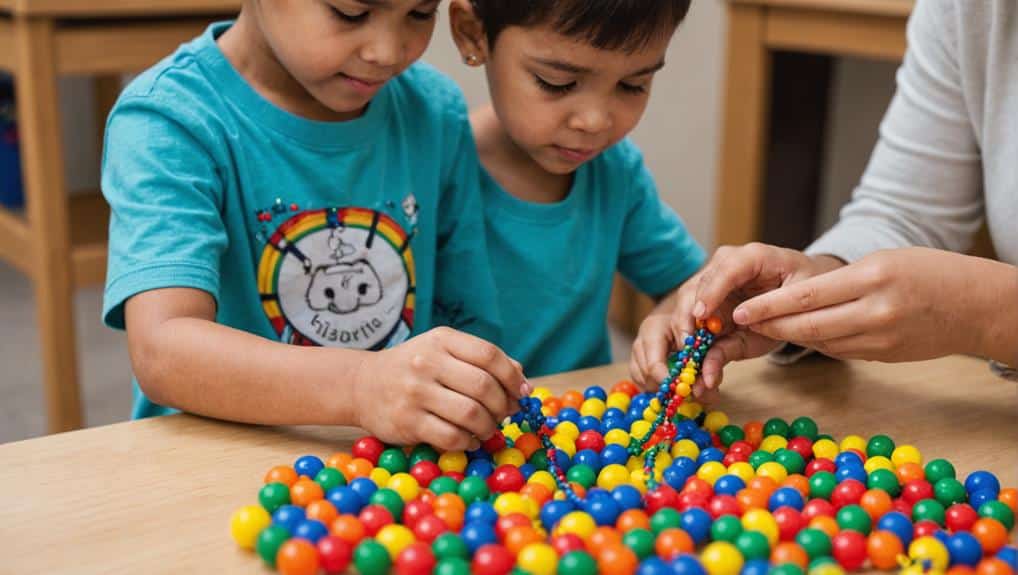
In pediatric care, occupational therapy for fine motor skills is crucial for helping children overcome neurological or physical differences. These therapies are tailored to each child’s specific requirements, promoting pediatric success through improving physical development.
- Pediatric occupational Therapy: This approach embodies a compassionate understanding of each child’s situation. Occupational therapists evaluate and diagnose delicate motor skill issues, creating treatment plans tailored specifically to the child’s neurological variances and physical abilities.
- Fine Motor Skill Activities: Integral to the therapy process, these activities are not just exercises – they serve as enjoyable, interactive platforms for skill development. Children enhance their fine motor skills through play, fostering independence and success in daily tasks.
- Individual Needs and Treatment Plans: Acknowledging that each child is exceptional, therapy for fine motor skills is personalized to address specific needs. This thorough, analytical approach guarantees that the child’s treatment is effective, sustainable, and enjoyable, contributing positively to their health.
Building Blocks for Motor Skills
The foundation of successful pediatric motor skill development lies in understanding and applying several building blocks. Hand-eye coordination is the synchronized control of eye movement with hand movement, which is crucial for catching a ball or threading a needle.
Next, hand and finger strength are essential in delicate motor tasks such as writing and manipulating objects. The ability to exert force with the hands allows children to effectively engage in everyday tasks, enhancing their independence and confidence.
Furthermore, bilateral integration, which involves coordinating both sides of the body, is vital for accomplishing motor tasks. This skill helps children develop body awareness and coordination, enabling them to move gracefully and efficiently.
Crossing midline skills are also essential. These involve moving one hand, foot, or eye across the body’s midline, improving overall coordination and enabling a more fluid execution of tasks.
Lastly, establishing hand dominance is crucial, allowing children to become more efficient and precise in their fine motor skills. We can successfully enhance a child’s fine motor skill development by strategically applying these building blocks.
Signs of Fine Motor Skill Problems
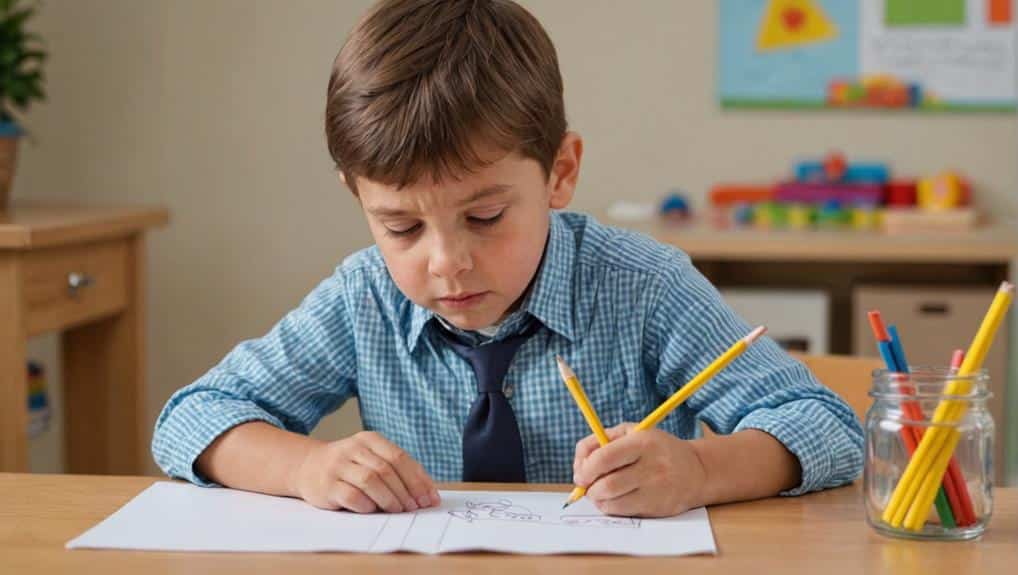
Recognizing the signs of delicate motor skill problems can be critical in a child’s development. One of the earliest indications may be an awkward pencil grasp, leading to slow or messy drawing and writing. Difficulty with scissors and other manipulation tasks may also be evident. Children experiencing these challenges may be exhausted by typing and other delicate motor tasks.
Behavior changes may also signal delicate motor skill problems. Frustration with coordination tasks may lead to changes in mood or demeanor. Often, this is accompanied by academic struggles, especially in tasks that demand fine motor skills, such as handwriting or using a computer.
Addressing these issues early is critical. Here are three signs to look for:
- Difficulty with delicate motor tasks: This may manifest as an awkward pencil grasp, slow or messy drawing/writing, or challenges with scissors.
- Fatigue with typing or handwriting: Watch for signs of exhaustion or frustration during these tasks.
- Behavior changes: Look for alterations in mood, particularly during tasks that necessitate coordination.
Enhancing Fine Motor Skills
Improving fine motor skills in children is an essential aspect of their complete development. They play a crucial role in achieving daily tasks and promoting independence. Participating in particular activities, from sensory play to art projects, can significantly enhance these skills by promoting hand-eye coordination and strengthening fingers. Additionally, the guidance and support of occupational therapists can be pivotal in creating a structured, practical approach to acceptable motor skill improvement.
Importance of Fine Motor Skills
Fine motor skills, encompassing the precise movements of small muscles in the fingers, hands, and forearms, serve as a cornerstone for everyday tasks. These skills lay the groundwork for a child’s ability to complete daily tasks independently, such as buttoning a shirt or tying shoelaces. The development of these skills contributes significantly to a child’s overall independence, self-confidence, and academic performance.
The importance of fine motor skills can be summarized in three key points:
- Small Muscle Development: Fine motor skills improve the strength and agility of a child’s hands and fingers. This small muscle development is crucial for writing, drawing, and manipulating small objects.
- Independence: Children can complete tasks independently as they develop their hand strength and fine motor skills. This independence fosters self-esteem and confidence, which are fundamental for their cognitive and social development.
- Academic Performance: Fine motor skills directly influence a child’s educational performance. Skills such as holding a pencil, cutting with scissors, and handling objects are vital to their learning process.
Engaging Activity Ideas
Many creative and engaging activities can effectively improve children’s fine motor skills. For example, sensory play activities such as manipulating sand or water beads encourage children to use the small muscles in their hands and fingers. This results in heightened fine motor skills and creates an engaging and enjoyable experience for the child.
Art-related activities such as drawing, painting, and molding clay enhance hand and finger strength. These activities allow children to express their creativity while simultaneously working on their fine motor skills. Board games, too, can serve a dual purpose. Games like LEGO Construction and Connect 4 engage children while promoting fine motor skills and hand-eye coordination.
Furthermore, everyday activities such as playing magnet fishing games or aligning stickers can strengthen fine motor skills and hand-eye coordination. The key here is to engage these activities enough to hold the child’s interest. With these fun and engaging activities, improving fine motor skills in a pediatric setting can be an enjoyable and successful endeavor.
Pediatric Occupational Therapy Support
Pediatric occupational therapy is a cornerstone in children’s journey toward improved fine motor skills. Through personalized activities tailored to specific needs, occupational therapy support provides a nurturing environment where children can thrive and develop the necessary skills for autonomy.
- Enhancing Hand-eye Coordination and Dexterity: Occupational therapy focuses on activities that improve hand-eye coordination and dexterity. These activities promote precise movements in fingers, hands, and forearms, increasing fine motor skills.
- Boosting Finger Strength: Finger-strengthening exercises play a significant role in occupational therapy. They are essential in skill development, allowing children to perform daily tasks with greater ease and self-reliance.
- Building Confidence and Success: Occupational therapists create a supportive environment where children can build confidence in their abilities. Success in diverse activities, thanks to improved fine motor skills, further strengthens their self-esteem.
Occupational therapy support is crucial in fostering fine motor skills development. Focusing on hand-eye coordination, finger strength, and agility enables children to gain independence and instills the confidence to navigate their world successfully.
Frequently Asked Questions
How to Improve Fine Motor Skills in Children?
Incorporate activities such as coloring, cutting, and bead threading to improve children’s fine motor skills. Provide tools like pencils and scissors to foster hand-eye coordination. Promote tasks requiring hand dominance and offer tailored occupational therapy when needed.
What Are 3 Ways to Encourage Children’s Development in Fine Motor Skills?
Introduce activities such as threading beads, drawing, and playing with playdough to encourage children’s development of small motor skills. These activities boost hand-eye coordination, fine motor control, and muscle strength, improving general motor skills.
How Do You Best Encourage a Child’s Fine Motor Skills and a Child’s Gross Motor Skills During the First Two Years of Life?
To best encourage a child’s motor skills in their initial two years, introduce toys requiring hand-eye coordination, provide ample space for physical exploration, and engage in object manipulation and texture exploration.
How can techniques to boost fine motor skills help my child succeed in school?
Boosting fine motor skills is crucial for your child’s success in school, as these skills are essential for writing, cutting, and manipulating classroom materials. When children develop better hand-eye coordination and dexterity, they become more confident and capable learners, making participating in activities and completing assignments easier.
How Can Teachers Help Children Develop Fine Motor Skills?
Teachers can foster fine motor skills in children by integrating activities like cutting, coloring, and tracing into their curriculum. Small objects and tools strengthen hand muscles and promote hand-eye coordination, enhancing complete motor development.
Conclusion
To sum up, fostering fine motor skills in pediatric development sets children up for success in numerous areas, such as cognitive growth, social interaction, and overall well-being. A range of activities, from art projects to everyday tasks, can significantly improve these skills. Early identification of motor skill issues and intervention through occupational therapy can further support this development. Continued research is necessary to expand on the most effective techniques for improving fine motor skills in children.


Recent Comments